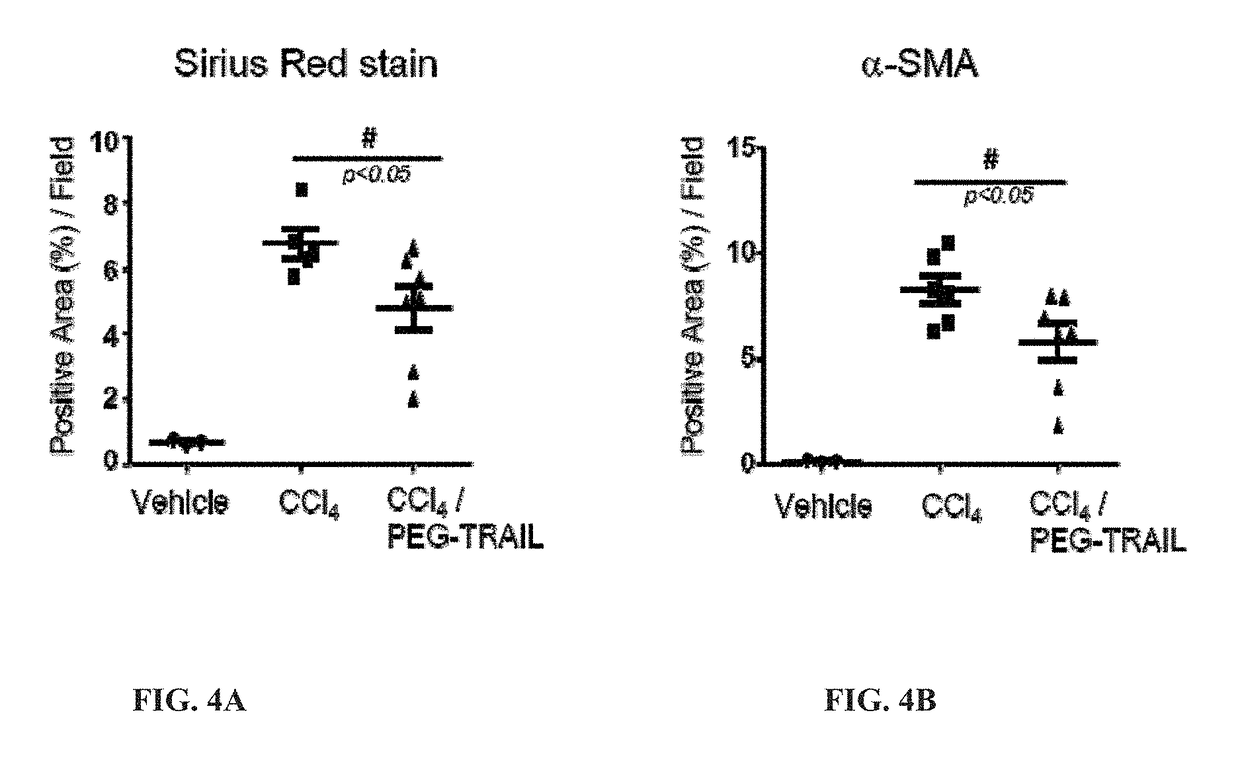Trail receptor agonists for treatment of fibrotic disease
a technology of fibrotic disease and receptor agonists, which is applied in the field of preparations and methods of treating fibrotic disease, can solve the problems of unfavorable clinical trials of antibodies in cancer patients, and achieve the effect of reducing the amount of ascites and unwanted scarring
- Summary
- Abstract
- Description
- Claims
- Application Information
AI Technical Summary
Benefits of technology
Problems solved by technology
Method used
Image
Examples
example 1
n of TRAIL-R1 / DR4 and TRAIL-R2 / DR5 by Activated Human Primary Hepatic Stellate Cells (HSCs) and Pancreatic Stellate Cells (PSCs)
[0228]Materials and Methods
[0229]Human Primary Stellate Cells
[0230]Human primary HSCs, PSCs and stellate cell medium (SteCM) were obtained from ScienCell Research Laboratories (Carlsbad, Calif.). Cells were cultured in SteCM medium supplemented with 2% of FBS, 1% of stellate cell growth supplement and 1% of penicillin / streptomycin solution in poly-1-lysin coated plates. To activate primary stellate cells, cells were then cultured in 6 well plastic culture plates for 1, 4, 7 and 14 days and harvested. The expression of DR-4, DR-5 and α-SMA in cultured stellate cells were determined by Western blot analysis and real time PCR.
[0231]Comparative Quantitative Real Time RT-PCR
[0232]Total RNA from cultured cells was extracted with TRlzol reagent (Life Technologies, Grand Island, N.Y.) and was reverse transcribed to cDNA using the Reverse Transcription System (Life ...
example 2
Human Primary HSCs and PSCs Demonstrate Enhanced Sensitivity to TRAIL Agonist-Induced Apoptosis
[0237]Materials and Methods
[0238]Immunofluorescence Staining of Apoptosis
[0239]Cells were plated on glass coverslips in 35 mm culture dishes (MatTek corporation, Ashland, Mass.) and grown for 1, 4, 7, and 14 days. Cells were then treated with or without TRAIL agonists including 1 microgram / ml (μg / ml) of TRAIL, PEGTRAIL or 50 ng / ml of anti-DR5 antibody (R&D systems, Minneapolis, Minn.) for 3 hours on those days. Cells were washed twice with cold PBS and fixed in 4% paraformaldehyde in PBS for 10 minutes. For detection of apoptosis, TdT In Situ Apoptosis Detection Kit (TUNEL)-Fluorescein (R&D systems, Gaithersburg, Md.) was used according to the manufacturer's instruction. Briefly, cells were incubated with proteinase K for 15 minutes at room temperature, then washed twice with DW, immersed with TdT labeling buffer, and then incubated with TdT labeling reaction mix at 37° C. for 1 hour. Next...
example 3
with TRAIL Prevents Liver Fibrosis
[0247]Materials and Methods
[0248]Liver Fibrosis Induced by CCl4 in Rats (Group 1)
[0249]6-8 week old SD rats (Hanlim Experimental Animal Laboratory, Seoul, Korea) were divided into 3 groups (8-10 rats per group); i) vehicle (olive oil), ii) 20% CCl4 in olive oil and iii) CCl4 in olive oil and TRAIL (Group 1, FIG. 2). Rats were administered CCl4 (20% CCl4 in olive oil, 2 ml / kg) three times per week via intraperitoneal injection or olive oil as a control for 4 weeks while simultaneously being treated with 4 mg / kg of intravenously administered TRAIL every three days or with the same amount of saline for control groups (Group 1, FIG. 2).
[0250]Liver Histology and Immunohistochemistry of Liver Fibrosis
[0251]After treatment, animals were sacrificed and collected liver tissues were fixed in 10% buffered formalin, embedded in paraffin, and cut into 4 m thick sections. The sections were then stained with hematoxylin and cosin (H&E). Immunohistochemistry was pe...
PUM
| Property | Measurement | Unit |
|---|---|---|
| molecular weight | aaaaa | aaaaa |
| molecular weight | aaaaa | aaaaa |
| molecular weight | aaaaa | aaaaa |
Abstract
Description
Claims
Application Information
 Login to View More
Login to View More - R&D
- Intellectual Property
- Life Sciences
- Materials
- Tech Scout
- Unparalleled Data Quality
- Higher Quality Content
- 60% Fewer Hallucinations
Browse by: Latest US Patents, China's latest patents, Technical Efficacy Thesaurus, Application Domain, Technology Topic, Popular Technical Reports.
© 2025 PatSnap. All rights reserved.Legal|Privacy policy|Modern Slavery Act Transparency Statement|Sitemap|About US| Contact US: help@patsnap.com



